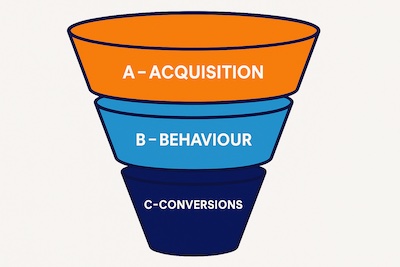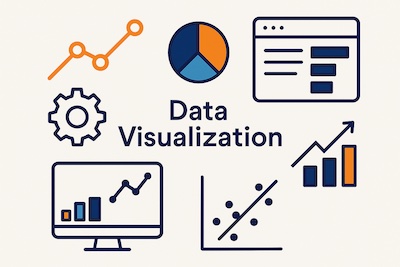In digital marketing, success isn’t about guesswork; it’s about measurable progress. Digital marketing KPIs (Key Performance Indicators) are the benchmarks that help you track and optimize campaigns, understand audience behaviour, and drive tangible business outcomes. Whether you’re running SEO, PPC, social media, or email campaigns, having clear KPIs helps you turn data into action.
This guide breaks down the most essential KPIs by channel, objective, and customer journey stage. Plus, a framework for how to choose and evolve the right metrics for your strategy.
- What are digital marketing KPIs?
- Why KPIs matter
- The ABC framework
- Types of KPIs by channel
- Types of KPIs by business objective
- How KPIs change over time
- How to track and measure KPIs
- How to choose KPIs for your business
What Are Digital Marketing KPIs?
Digital marketing KPIs are measurable values that track the effectiveness of online marketing campaigns. Common KPIs include website traffic, conversion rate, cost per acquisition (CPA), return on ad spend (ROAS), and customer lifetime value (CLV). Businesses use KPIs to assess performance and optimize strategies for better results.
KPIs ≠ metrics. While all KPIs are metrics, not all metrics are KPIs. KPIs are the most critical metrics tied directly to your objectives. For example, some metrics called vanity metrics such as follower count and post likes feel good but don’t drive business results.
Why Digital Marketing KPIs Matter
Without KPIs, you’re flying blind. The right KPIs help you:
- Track campaign ROI
- Identify underperforming channels
- Prioritize high-converting strategies
- Optimize ad spend and content production
- Align marketing with business goals
The ABC Framework for Marketing KPIs

A simple framework to pick and categorize your KPIs is the ABC model: Acquisition, Behaviour, Conversion. Likely first popularized by Avinash Kaushik, the ABC framework ensures you’re not just attracting traffic but nurturing it through the funnel and converting it into business value.
A – Acquisition KPIs
These measures show how people are discovering your brand. In other words, how are you acquiring customers. Here are a few standard acquisition metrics.
- Organic traffic (SEO)
- Cost per click (PPC)
- Social reach
- Email open rate
- Referral traffic
B – Behaviour KPIs
Once you have acquired a visitor, what do they do? Behaviour metrics track what users do once they land on your site. These KPIs will be action-oriented. These are some our our favourite behaviour KPIs to track.
- Pages per session
- Bounce rate
- Scroll depth
- Time on site
- Video engagement
C – Conversion KPIs
These metrics reflect actual business outcomes or conversions. You’ll want metrics that tie to revenue in this category. For example, leads generated can be tied to sales generated, and you can then create a close rate metric that can help you understand the quality of your leads.
- Leads generated
- Cost per acquisition (CPA)
- Conversion rate
- Revenue per visitor
- Customer lifetime value (CLV)
Types of Digital Marketing KPIs by Channel
Once you have selected top-level KPIs using the ABC framework, you can go deeper into channel-specific KPIs. This lets you analyze each of your marketing channels individually so that you can make improvements based on specific data. Think of this step like going down to the street level with Google Maps, where you can see the details of the shops. Similarly, channel-specific KPIs allow you to measure and adjust for the nuances of each platform.
SEO KPIs
- Organic impressions (visibility)
- Keyword rankings
- Click-through rate (CTR)
- Bounce rate
- Backlink growth
Heads up: As we’ve discussed in our post about how AI Mode works, traditional SEO KPIs like clicks are less reliable today. Thanks to zero-click searches and SERP features like AI Overviews and AI Mode, visibility metrics—such as search impressions and share of voice—are now more indicative of performance.
PPC KPIs
- Cost per click (CPC)
- Quality Score
- Conversion rate
- Return on ad spend (ROAS)
- Impression share
Social Media KPIs
- Engagement rate
- Reach and impressions
- Follower growth
- Social share of voice
Email Marketing KPIs
- Open rate
- CTR
- Unsubscribe rate
- Email list growth
- Email ROI
KPIs by Business Objective
Brand Awareness
- Impressions
- Reach
- Branded search volume
- Social mentions
Lead Generation
- Leads per channel
- Cost per lead (CPL)
- Landing page conversion rate
Revenue & Retention
- Customer acquisition cost (CAC)
- Customer lifetime value (CLV)
- Average order value (AOV)
- Churn rate
How KPIs Change Over Time

Digital marketing is constantly evolving, and so should your KPIs. For example, SEO used to be all about rankings, and now it’s about visibility and engagement due to zero-click results and Google’s evolving SERPs (Search Engine Results Page). Another example is email marketing, where open rates are becoming less reliable due to privacy changes in iOS and Gmail. You’ll want to tie emails to conversions by tracking email website traffic or comparing send times with website activity.
Make sure to review your KPIs regularly and determine whether they remain relevant or if a new metric would be better. You’ll also want to be on the lookout for new tools and ways to measure success.
How to Track & Measure Digital Marketing KPIs
There are two aspects you’ll need to consider when determining how to track and measure your KPIs: data capture and data visualization.
Data capture
You’ll need to pick a tool that will help you capture or record the necessary data. To figure out what you need to track, first set your goal and then complete a tag matrix. For website owners, here are the most common tools:
- Google Analytics 4 (GA4) which replaced Universal Analytics on July 1, 2023, for measuring website traffic and visitor behaviour
- Google Search Console for understanding how your website performs on Google
- A Tag Management System, like Google Tag Manager (GTM), to help you keep your tracking pixels organized and make tracking unique visitor behaviour simple to manage.
- CRM or marketing automation software to help you track conversions
Beyond the standard tools, here are some other tools to consider:
- Ahrefs / SEMrush (for SEO)
- Facebook Ads Manager / Google Ads dashboard
There are many other tools out there to help you measure what you need, so be sure to do a bit of research and plan out your data management strategy. A data ecosystem audit can help you.
Before moving on, here are a couple of additional best practices to consider. While many systems provide automated recognition of your campaigns and the source of traffic, we recommend that you still implement UTMs on most of your URLs. This ensures consistency across your campaigns.
You’ll want to set benchmarks for your goals. This is so that as you review your KPIs and other metrics, you’ll have a basis to understand whether the result is good or needs improvement. These can be adjusted for current market situations, too, but they should be used primarily as a high-level indicator that you’re moving in the right direction.
Lastly, it’s a good idea to customize your KPIs or at least have campaign goals set. This allows you to drill in when needed to assess individual campaigns and their performance outside of any influence that other campaigns may be causing.
Data visualization

Once you have your data, you’ll need a way to organize and visualize your KPIs to make them easy to understand and see trends. This can be done using dashboarding software like Looker Studio or Tableau.
As you develop your dashboard, keep these principles in mind:
- Tell a story – The data should be presented in a way that flows from one part to the next. Each block should support the other blocks in helping people understand performance.
- Start high-level and then move to specifics. The top of your dashboard should highlight overall metrics. Then, as you get deeper into your report, you can get into more specific data like campaign-level insights.
- Use visual hierarchy to emphasize key points. Try bolding items or making important KPIs bigger and less important items smaller.
How to Choose the Right KPIs for Your Strategy
Choose the right KPIs by aligning them with your business goals, measuring progress toward specific outcomes, and ensuring they are quantifiable and actionable. Focus on metrics that directly impact performance, such as customer acquisition cost, conversion rate, or revenue growth tied to strategic objectives.
Here are the steps to choosing the right KPIs:
- Start with the goal (e.g. brand awareness, leads, revenue)
- Select 3–5 KPIs that align with that goal (e.g. brand awareness = impressions)
- Use benchmarks to define realistic targets
- Avoid vanity metrics that don’t impact business goals (e.g. instead of followers and likes measure total content engagement)
- Evaluate monthly, and refine as needed
Your KPIs should remain stable, but the tactics you use to improve them should evolve as you gain insights during your monthly checks.
How do you balance short-term versus long-term KPIs in digital marketing strategy?
Balance short-term and long-term KPIs in digital marketing by linking immediate performance metrics—like click-through rates or conversions—to broader goals such as brand equity or customer lifetime value. Use short-term KPIs to optimize campaigns while tracking long-term KPIs to guide strategic growth and ROI.
What are the best practices for integrating offline conversions into digital KPIs?
Integrate offline conversions into digital KPIs by using CRM data, call tracking, and unique promo codes to link offline actions to online sources. Attribute leads or sales to specific digital campaigns, then update your KPIs to reflect full-funnel performance across online and offline touchpoints.
For example, if you are a real estate agent who advertises on a billboard, you can use a unique phone number, website address or QR code for people to contact you. When a person uses one of those methods to contact you, you’ll be able to recognize where they found out about your business.
How can you account for multi-touch attribution when setting and interpreting KPIs?
Account for multi-touch attribution when setting KPIs by assigning value to each interaction across the customer journey. Use models like linear, time decay, or position-based attribution to measure the impact of all touchpoints. Align KPIs with these models to reflect true campaign performance.
What role do predictive analytics and machine learning play in forecasting KPI performance?
Predictive analytics and machine learning forecast KPI performance by analyzing historical data to identify patterns and trends. These tools generate data-driven predictions, helping marketers anticipate outcomes and adjust strategies proactively. Use them to optimize budget allocation, campaign timing, and overall performance tracking.
How should privacy regulations (such as GDPR or CCPA) influence the approach to digital KPI tracking and measurement?
Privacy regulations like GDPR and CCPA should influence KPI tracking by requiring user consent, limiting data collection, and enforcing transparency. Marketers must prioritize anonymized, aggregated data and use compliant tools to measure performance while respecting user rights and avoiding legal penalties.
Final Thoughts: Start Measuring What Matters
KPIs are more than just numbers on a dashboard. They are the roadmap that ensures your digital marketing efforts are strategic, intentional, and aligned with your business goals. By regularly reviewing and refining your KPIs, you’ll not only measure success but also uncover opportunities to optimize campaigns and improve ROI.
Remember, digital marketing evolves with time. The platforms, tools, and customer behaviours will continue to update. Staying proactive with your measurement strategy ensures you adapt to these changes rather than fall behind. Keep your KPIs tightly tied to business outcomes, and let data-driven insights guide your decision-making.
If you’re ready to take the guesswork out of your digital strategy and want expert support in choosing, tracking, and optimizing the right KPIs for your business, connect with a digital marketing consultant. With the right guidance, you can turn data into meaningful action and drive growth that lasts.
